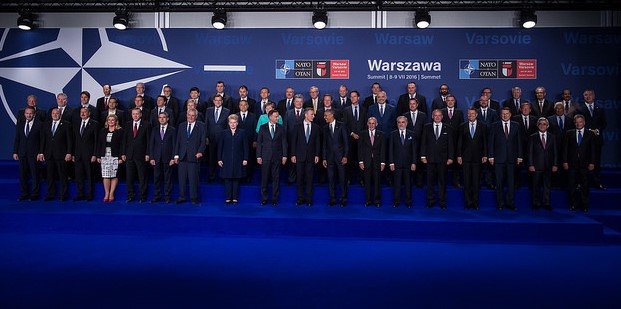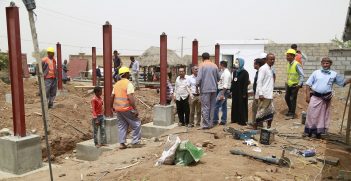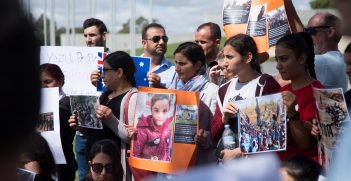NATO Summit: Collective Defence and Nuclear Deterrence

When the NATO heads of state and government convened in Wales in 2014 following Russia’s invasion of Ukraine, their meeting was widely heralded as historic; yet it is likely that last week’s Warsaw NATO Summit will be the more important one. This is because it is only now that NATO genuinely has returned to its roots as an alliance devoted to the collective defence of its member states.
NATO summits provide a regular drumbeat for the alliance’s policy work and defence preparations, which alternate between years of implementation and years of seeking consensus for the next summit’s decisions. When the allies met in Wales in 2014, their focus was on reassuring Eastern member states: in particular the Baltic countries, Poland and Romania. These states had joined NATO to seek protection from Russia but had seen very little practical steps to prepare for their defence while the alliance was focused on Afghanistan and other out-of-area operations in the Middle East. A rotational presence of small allied forces for training, increased exercises and the creation of a relatively light, brigade-sized “Very High Readiness Joint Task Force” were the main elements of the “Readiness Action Plan” that was the centrepiece of the 2014 summit.
As contentious as these reassurance measures were two years ago, the decisions of this year’s Warsaw Summit show how NATO members have accepted in the meantime that actual preparations for collective defence and deterrence against the threat from Russia will from now on have to become central to their defence effort once more. Ten years after a politically painful reform of the NATO command system that saw many headquarters closed and geographical areas of responsibility removed, the alliance will now conduct a “functional review” that is likely to bring back greater focus on operations on alliance territory.
Allied nations will send four multinational battalions—to Estonia, Latvia, Lithuania and Poland—led by the UK, Canada, Germany and the US. These battalions will train with the host nations but be combat-ready and under the permanent command of NATO’s supreme commander. Even combined with a US heavy brigade which is also returning to Europe, these forces are far from sufficient to defend the Baltic States against a Russian invasion. But Russia cannot now invade without having to kill or capture thousands of troops of NATO’s major member states, including those of at least two nuclear powers. Indeed, the Warsaw Summit communiqué is one of the most unequivocal affirmations of the security value of nuclear weapons in many years, stating that:
The strategic forces of the alliance, particularly those of the United States, are the supreme guarantee of the security of the allies. The independent strategic nuclear forces of the United Kingdom and France have a deterrent role of their own and contribute to the overall security of the alliance. These allies’ separate centres of decision-making contribute to deterrence by complicating the calculations of potential adversaries.
In what may come as a disappointment to the global disarmament community, including in Australia, the allies clearly state that “the conditions for achieving disarmament are not favourable today.” Instead, “These allies will ensure that all components of NATO’s nuclear deterrent remain safe, secure, and effective”, and “The alliance will ensure the broadest possible participation of allies concerned in their agreed nuclear burden-sharing arrangements.” Drawing a thinly veiled link to the security of the Baltic States and the possibility that NATO might use nuclear weapons first if necessary to preserve the integrity of one if its members, the communique states that:
The circumstances in which NATO might have to use nuclear weapons are extremely remote. If the fundamental security of any of its members were to be threatened however, NATO has the capabilities and resolve to impose costs on an adversary that would be unacceptable and far outweigh the benefits that an adversary could hope to achieve.
Over the last two years, significant work has already been done in NATO and its member states to reinvigorate the capacity for collective defence and some of the additional statements produced by the summit demonstrate the tasks ahead. NATO and the EU agreed to work more closely in managing both “hybrid” threats and security in the Mediterranean; member states made commitments to improve their national security in a “cyber defence pledge”; and there was a “commitment to enhance resilience”. The latter comprises measures to ensure continuity of government and of essential services and ensure the ability of military forces to draw on civilian support in crisis situations—reversing the focus on military support to internal security and instead bringing the practicalities of national mobilisation back onto the agenda. For NATO partner Australia, a new NATO division and a new assistant secretary-general for intelligence and security are particularly relevant as they promise additional scope for intelligence links beyond the five-eyes community.
All of these measures were complemented by signs that individual member states are also adjusting their defence postures to the new situation. Having withdrawn across the Atlantic after the Cold War, Canada’s land forces are now returning permanently to Europe. While defence spending in many countries remains below the objective of 2 per cent of GDP, Europe’s decline in defence spending has ended and reversed, including a 7 per cent rise in Germany’s budget next year. The German Army is looking to reactivate rapid mine dispersal equipment and acquire new tank folding bridges. It is a sign that the NATO defence-planning process, as part of which the heads of government review detailed NATO reports on each country’s plans at their summit meetings, is rebuilding capabilities once thought superfluous in the era between 9/11 and 2014.
Of course, this does not mean that challenges in NATO’s south and southeast have subsided. In what would at other times have been the central announcements of the summit, NATO agreed to halt the planned reduction of its forces in Afghanistan; increase its support to the government of Iraq; provide Boeing E-3A Airborne Warning & Control System (AWACS) planes to the coalition against ISIS; and reorganise and expand the tasks of its naval operation in the Mediterranean.
The Warsaw Summit was the first in several years where NATO’s global partnerships, including with Australia, received little attention. NATO’s focus is clearly turning inwards and towards its immediate neighbourhood. Given the uncertainties surrounding Brexit and the economic and political weakness of major powers such as France and Italy, Europe is likely to be preoccupied with its own problems for years to come. China and the South China Sea are simply too remote to receive much attention in Europe at this time. But the Warsaw Summit is a sign that the transatlantic community is beginning to rise to the challenges it faces. That this is ultimately a good development for Australia, too, is perhaps a sign of how challenging the security situation of the Western World as a whole has become.
Dr Stephan Frühling is an associate professor in the Strategic and Defence Studies Centre of the Australian National University. This article is published under a Creative Commons Licence and may be republished with attribution.





